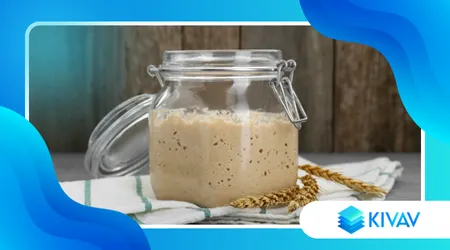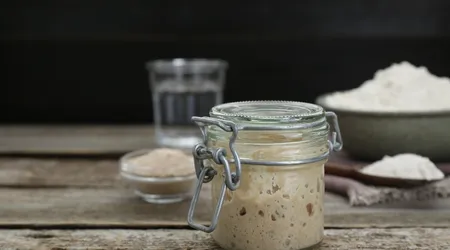Natural Leavening: A Basic Guide

Natural leavening, an art that smells of tradition, is experiencing a renaissance in Italian kitchens.
Announcements
In an age dominated by speed, the return to natural leavening It represents a silent rebellion against food industrialization.
This method, which uses only flour, water, and time, is not just a technique, but a dialogue with nature, a process that requires patience and respect.
In 2025, with the increasing awareness towards healthy and sustainable foods, the natural leavening it establishes itself as an ethical and tasteful choice.
According to Slow Food, 68% of Italians prefer naturally leavened baked goods for their digestibility and authentic flavor.
Announcements
This guide explores the fundamentals of natural leavening, offering practical advice, concrete examples, and a modern approach to an ancient tradition. Why choose slow cooking?
Let's find out together.
The goal is not just to teach a technique, but to inspire a shift in perspective.
There natural leavening It's not a simple chemical process: it's a philosophy that celebrates the complexity of simplicity.
Through this guide, I will lead you step by step, with practical examples and clear language, towards creating your own sourdough starter.
Get ready to get your hands dirty and discover a world of flavors that only time can provide.
What is Natural Leavening?
There natural leavening It is based on a dough of flour and water, fermented by wild yeasts and lactic acid bacteria present in the environment.
These microorganisms convert sugars into carbon dioxide, causing the dough to rise.
Unlike brewer's yeast, the natural leavening produces complex aromas and a unique honeycomb structure.
++ How to make lump-free béchamel sauce
This process, also known as sourdough, is as old as civilization itself. The Egyptians were already using it 4,000 years ago.
Today, the natural leavening It is appreciated for its digestibility, thanks to the degradation of phytic acid.
It's not just chemistry: it's a balance between science and intuition. Every sourdough starter is unique, influenced by the environment and the hands that nurture it.

How to Make Sourdough Starter from Scratch
To get started, you'll need flour, water, and patience. Mix 100g of type 1 flour and 50ml of warm water in a glass jar. Cover with a damp cloth and let it rest at 25°C for 48 hours.
After two days, discard half the dough and add 50 g of flour and 25 ml of water. This "refreshment" nourishes the microorganisms.
Repeat every 24 hours for a week. You'll notice bubbles and a sour smell.
A tip? Add a teaspoon of honey to the first batch of dough to speed up fermentation. After 7-10 days, the yeast will be ready for baking.
See also: Differences between fresh and dried pasta
Choosing the right flour is crucial. Opt for organic, stone-ground flour, rich in nutrients that support active microorganisms.
Practical example: Maria, a housewife from Bologna, created her own sourdough starter in eight days, using durum wheat flour. Today she's making bread.
Refreshment and Management Techniques
Refreshing the sourdough starter means feeding it regularly. Weigh out 100 g of yeast, add 100 g of flour, and 50 ml of water. Knead and let rest for 4 hours.
Store the yeast in the refrigerator at 8°C, refreshing it every 5-7 days. For frequent use, keep it at room temperature, refreshing it daily.
If the yeast “falls asleep”, give it a “bath”: immerse it in warm water with a pinch of sugar to reactivate it.
A common mistake? Using too much water. Stick to the 1:1:0.5 ratio (yeast:flour:water) for a strong, balanced yeast.
Example: Luca, a pizza chef from Naples, refreshes his yeast every 4 days, resulting in light and aromatic pizzas that are appreciated by his customers.
Leavening in the Kitchen: Proportions and Times
For bread, use 50 g of sourdough starter for every 500 g of flour. The hydration varies: 50% for rustic breads, 80% for focaccias.
There natural leavening It takes 12-24 hours. A trick is to let it rise in the refrigerator for 12 hours, which develops complex flavors.
Fold the dough every 30 minutes to strengthen it. This creates an elastic structure, ideal for perfect air bubbles.
Temperature is key: at 26°C, the dough doubles in 6-8 hours. In winter, use a turned-off oven with the light on.
Analogy: the natural leavening It's like a fine wine. The more time you give it, the richer its character becomes.
Mistakes to Avoid and Practical Solutions
Failure to refresh regularly weakens the yeast. Solution: Plan your refreshments on a calendar, even on vacation.
Using refined flour reduces microbial activity. Choose whole wheat or type 1 flours for vigorous yeast growth.
Extreme temperatures slow or kill microorganisms. Keep the yeast between 20-28°C (68-82°F) during initial fermentation.
If the dough doesn't rise, check the hydration level. A dough that's too dry won't ferment. Add water gradually.
A pungent odor indicates hyperacidity. Refresh the yeast with more flour to rebalance the yeast's pH.
Natural Leavening in 2025: Trends and Innovations
In 2025, the natural leavening It evolves with modern techniques. Smart ovens regulate temperature and humidity for perfect leavening.
Baking apps, like “LievitoVivo,” track refreshments and suggest personalized recipes, simplifying management.
Online courses by masters like Oscar Pagani teach how to use liquid sourdough starter, which is more versatile for pizzas and desserts.
Sustainability is at the heart: the sourdough starter reduces waste, using local flour and natural processes.
Statistics: 42% of Italian bakeries use sourdough starter, according to a 2024 Italian Gourmet survey.
Benefits of Natural Leavening
There natural leavening improves digestibility, thanks to the lactic bacteria that break down complex proteins, reducing gluten.
Sourdough products last longer. The natural acidity inhibits mold, keeping the bread fresh.
The flavor is unparalleled: fruity, acidic, and toasted notes emerge from the slow fermentation, delighting the palate.
From a nutritional point of view, the natural leavening increases the bioavailability of minerals such as iron and zinc.
Bread and pizza become sensory experiences, not just food. Every bite tells a story of care and tradition.
Table: Proportions for Natural Leavening
| Recipe | Mother Yeast | Flour | Waterfall | Rising Time |
|---|---|---|---|---|
| Bread Rustic Bread | 50 g | 500 g | 250 ml | 12-18 hours |
| Neapolitan Pizza | 40 g | 400 g | 240 ml | 18-24 hours |
| Genoese Focaccia | 60 g | 500 g | 400 ml | 24 hours |
Conclusion: A Journey of Flavors and Tradition
There natural leavening It's not just a technique, but a journey that connects past and present. It's an invitation to slow down, to rediscover the pleasure of creating with your own hands.
In 2025, this ancient method will be enriched with innovations, making it accessible to all.
Whether you are a beginner or an expert, the natural leavening It will surprise you with authentic flavors and profound satisfaction. All you need is flour, water, and a pinch of curiosity: your sourdough starter awaits.
What will be the first bread you bake?
With every refreshment, you are not just nourishing a dough, but cultivating a tradition that has lived for millennia.
There natural leavening It's an art that grows with you, a dialogue between nature and creativity.
Start today, and let the smell of homemade bread fill your kitchen. Have a good journey. natural leavening!
Frequently Asked Questions
How long does it take to make a sourdough starter?
About 7-10 days, with daily refreshments, but it may vary depending on the flour and temperature.
Can I freeze sourdough starter?
Yes, after a refreshment, freeze it for up to 3 months. Reactivate it with subsequent refreshments.
Why isn't my dough rising?
It could be weak yeast, incorrect hydration, or a suboptimal temperature. Check these factors.
Is liquid sourdough better than solid sourdough?
It depends: the liquid is more versatile for pizzas, the solid for large leavened products like panettone.
